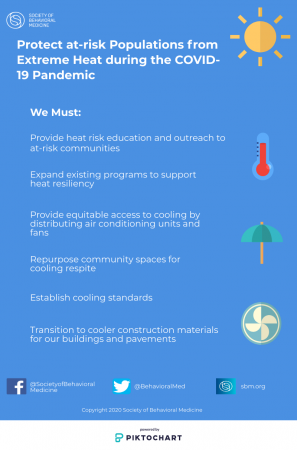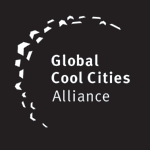Recommendations from GCCA, Society of Behavioral Medicine and others provide a roadmap for cities to address dangerous heat during the COVID-19 pandemic.

A new policy brief from the Society of Behavioral Medicine lays out a roadmap to help cities adjust their approach to preparing for compounding health challenges dangerous summer heat and COVID-19. The brief was developed in close collaboration with the Global Cool Cities Alliance, WE ACT for Environmental Justice, researchers from the Icahn School of Medicine at Mount Sinai, and staff in the Mayor’s Office of Resiliency.
Heat is a serious and growing public health threat in the U.S. and is already the most lethal weather-related disaster in an average year. The burden of heat is disproportionately borne by communities of color, non-US citizens, individuals with limited English proficiency, older adults, people with pre-existing medical conditions and low-income communities. These communities facing increased risk of negative heat health outcomes are also at the greatest risk of dying from COVID-19
At the same time, many states have issued stay-at-home and physical distancing orders to limit the transmission of COVID-19 including the closure of cooling centers, public pools, malls, and movie theaters and other places people can gather to cool off. During the COVID-19 pandemic, individuals without properly cooled residences may be less able to safely access emergency cooling options (e.g.,
community cooling centers) and more likely to spend time indoors in dangerous thermal conditions.
“We recognized that the already daunting health problem of addressing dangerous urban heat was going to be exacerbated greatly by the COVID-19 pandemic and that cities could use a practical, implementable roadmap to navigate this summer and beyond” says Dr. Sarah Miller, Assistant Professor at the Icahn School of Medicine at Mount Sinai.
The brief, which has been endorsed by the National League of Cities, lays out a series of recommendations for cities, including providing energy-efficient space cooling at low or no cost to people with a high risk of heat health problems, advocating for summer energy bill reductions, enhancing awareness and outreach efforts, establishing cooling standards, and committing to a transition to cooler construction materials such as highly solar-reflective roofs, walls, and pavements.
“Everyone deserves to live and work in safe conditions – including safe air temperatures – and we must act now to make sure that happens for our residents most at risk from the impacts of extreme heat. New York City is already implementing many of the recommendations described this brief in preparation for the 2020 summer season.” says Kizzy Charles-Guzman of the New York City Mayor’s Office of Resiliency.
“The brief recognizes the need to act immediately to meet the challenges of this summer, but it also provides actionable recommendations to transform cities into more heat-resilient, healthier places to live. Choosing cooler building materials and adding green space will generate substantial long-term benefits for people’s health, well-being, and budgets – particularly when focused in communities and populations at high risk for heat health problems” says Kurt Shickman of the Global Cool Cities Alliance.
The brief may be downloaded here. A summary infographic is available here.
